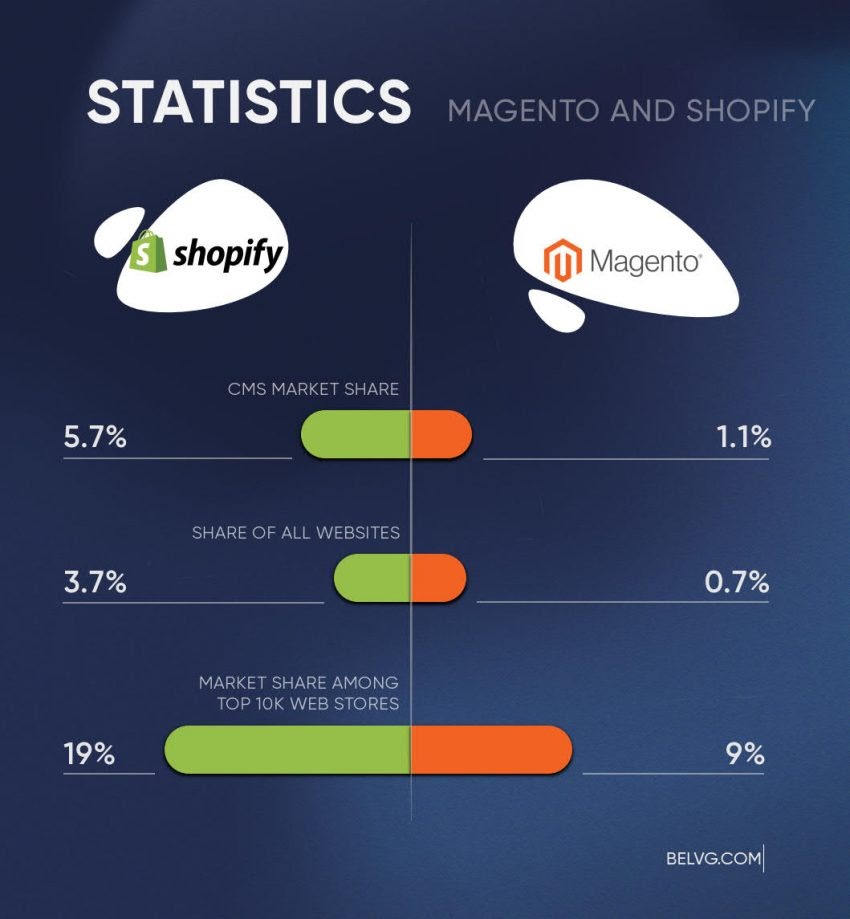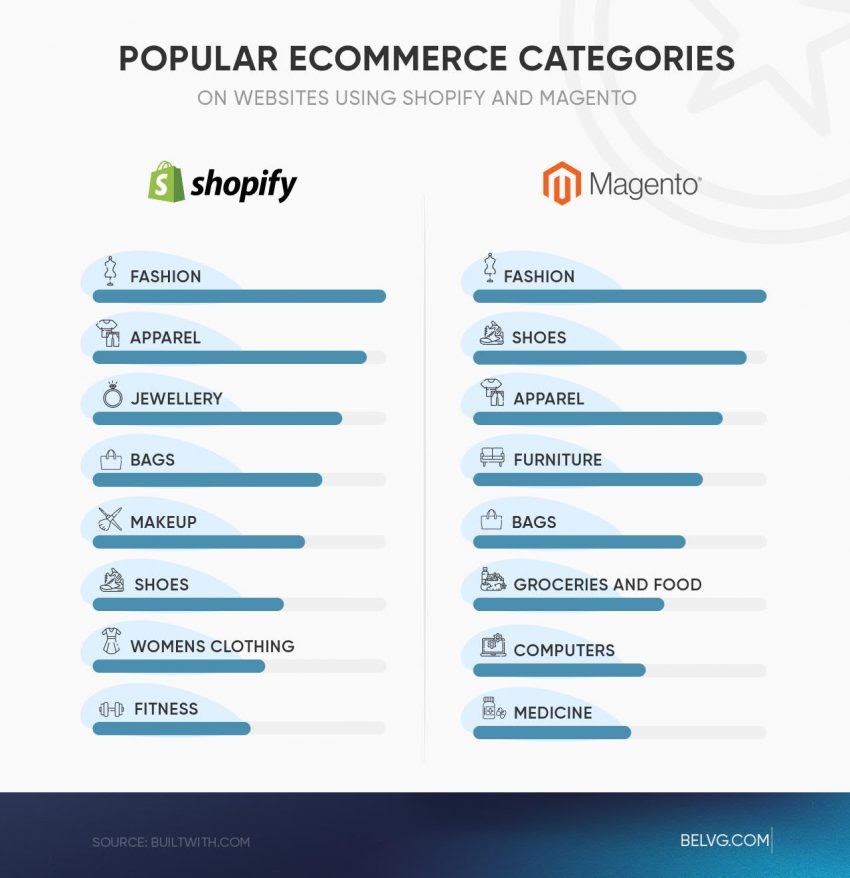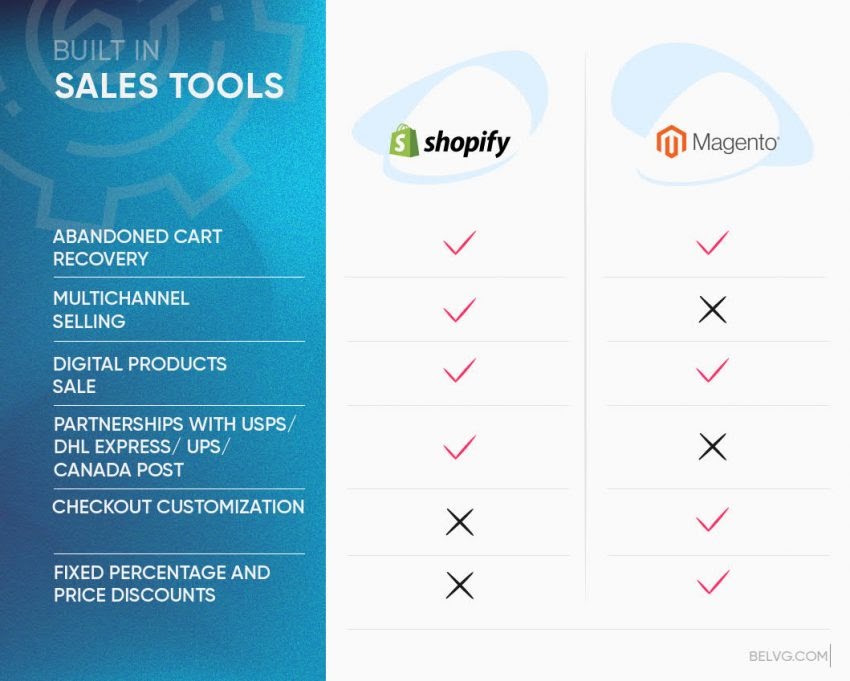Magento and Shopify are well-known technologies used by Ecommerce businesses. No wonder it is hard to choose the one for your online store. To help you decide if you need Shopify or Magento, SmartOSC prepared a full comparison review. It covers the functionality, price, and scalability of the two platforms: choose wisely and earn more.
Magento or Shopify – Which One is More Popular
Both Magento and Shopify are leading the Ecommerce market: they are used the most among the top 10k websites. Still, the stats for both are pretty different.

Although Shopify has twice the market share, Magento is used by such giants as Ford, Bulgari, Liverpool FC, PePe Jeans. These are all enterprise-level businesses that collect a high traffic volume. Meaning their websites must be robust, secure, and flexible regarding payments, shipping, and design.
If we take a look at the industries that commonly use Magento and Shopify websites, we get a further understanding of their differences.

As we see in the infographic above, Shopify is used a lot for websites of such industries as clothing, jewelry, and makeup. These are the markets that require both functional and esthetic delight. It explains the platform’s focus on various beautiful themes.
►►►► Please visit our products: Magento POS, BigCommerce POS, Shopify POS, Woocommerce POS, NetSuite POS, Mobile POS, White label POS, Reseller POS, POS System for Retail and Commercetools POS
Conclusion
Shopify is one of the most widespread Ecommerce platforms and one of the most used CMS on the Internet. It is easy to explain by Shopify’s ease of use, great variety of themes and apps. On the other corner is Magento that is more popular within enterprise-level websites as they need flexibility, multilingual support, and powerful hosting. Magento is less popular, but most of the websites on the platform collect an exclusively high volume of traffic.
Editions of Magento 2 and Shopify Plans
Before getting to the main battle of Magento vs Shopify, let us briefly differentiate between Magento versions and describe Shopify plans.
Magento Open Source and Magento Commerce
There are two versions of Magento CMS:
- Magento 2 Open Source formerly known as Magento Community Edition;
- Magento 2 Commerce, which was recently renamed as Adobe Commerce to mark the third anniversary since Adobe had acquired Magento.
In simple words, Open Source is a free edition – you can download it and modify the code. Using the platform, you can implement unique features as long as you have enough coding knowledge.
Adobe Commerce is a paid edition. It tends to be superior to the Open Source edition: more secure with cloud availability and such features as B2B functionalities and Magento Page Builder. The last two call for special attention:
- Open Source edition has no tools to alter pages, so administering a shop is rather challenging. Using Page Builder you have no problems adding pages, changing them as needed, adding content with simple drag-and-drop functions.
- B2B functionalities that Commerce edition offers allow different companies to self-manage their accounts on your B2B website, control prices, and track orders. For B2B buyers, it is easy to place orders, save shopping lists, and request quotes.
These features, together with security and live support, are particularly significant for the large catalogs. Small and medium businesses are good to go with the free option.
The main difference between the two editions is the price. Magento charges no fee for the Open Source solution. The license for Commerce edition costs from $22,000 to $125,000 per year depending on the annual Gross Merchandise Value (GMV). GMV is the total amount of products sold by the company in a specific period.
The Adobe Commerce features that Open Source lacks:
- Better security
- 24/7 support from Magento including dedicated account manager and real technical specialist on the line
- Drag-and-drop Page Builder
- B2B features
Both options still offer:
- Marketing and promotion tools
- Checkout, payment, and shipping integrations
- Analytics and reporting
- Global selling
See more articles: Magento Agency
Shopify Pricing Plans
The platform offers three plans for an online store:
- Basic ($29/month) – the solution for a small business. It offers no built-in opportunity to sell internationally, you can only create two accounts for the staff, credit card rates are quite high and the transaction fee equals 2%. So if the products are expensive or you are going to sell lots of them, the expenses will soon add up due to these additional charges.
- Shopify ($79/month) – option for a growing small business. Here you are allowed to create 5 staff member accounts, you’re getting monthly reports, and can even create international pricing. Also, the credit card rates and transaction fees are lower. Starting from this plan you are getting a full 88% discount from Shopify partner carriers. These features are not so important for a small business but take on new value when the store is reaching the point of about $5,000 monthly revenue.
- Advanced Shopify ($299/month) – plan with 15 staff accounts, detailed advanced reports as well as lower transaction fees and credit card rates. This plan also includes the features for international selling, so if you are going to grow to at least $10,000 of monthly revenue and maybe sell internationally, this is your plan. It is pricey, but lower additional rates and new features fully make up for that.

There is also a fully hosted Shopify Plus solution for enterprise-level businesses and Shopify Lite. The latter integrates with an existing online solution and makes it possible to accept credit cards and create invoices.
Shopify versus Magento: Overall Review
When making a choice, you have to decide what is more significant for you. Usability and a bunch of eye-pleasing themes that Shopify offers or flexibility and scalability that Magento is providing. The former is more recommended for aspiring business owners, while the latter is suitable for large brands and enterprises.
To compare the two systems, let’s move on to the features you need to consider:
- hosting
- pricing
- ease of installation and usability
- themes
- marketing, sales, and SEO features
- apps
- payment and transaction
- additional features
- scalability and flexibility
- support
Having compared platforms for each of these features, you can make the right decision.
Hosting
Shopify is a hosted solution meaning that the company takes care of all your hosting issues. You pay a monthly fee both for the CMS with its features and for the hosting. Shopify uses a CDN hosting service operated by Fastly. In simple words, this is a network of servers located around the world. The provider claims that the system allows web stores to load fast no matter what continent your buyers are on.
Magento is self-hosted, meaning you need to take care of the hosting solution yourself. There is a plus in the situation because you are free to choose something more powerful or cheaper. It is more cost-efficient as you can change the pricing plan at any time without paying extra if your traffic isn’t as high as you expected it to be or vice versa if the number of visitors surpasses your expectations.
That is relevant for an Open Source edition, if you buy a Magento Commerce license, you get access to a pre-installed cloud features and cloud hosting. There is a choice between Amazon Web Service or Microsoft Azure, as a result you get the same features that any SaaS provider offers: built-in security, performance optimization, and managed cloud infrastructure. It is also using a CDN system to get you prepared for the traffic peak periods.
Conclusion
No doubt, it is convenient to pay for CMS and hosting together, but Magento enables you to choose your provider. It saves a lot of money: if making the right choice, you will only pay for what you use, without the risk of overpaying. You are also free to switch plans as you grow or get something more powerful.
Shopify doesn’t let you choose: you pay what you owe and get limited control over the issue. Although the hosting itself is good: it is enough for small and medium-sized businesses.
Pricing
Without much investigation, we claim that owning a Magento shop is more expensive. Even though Magento 2 Open Source Edition is free, you cannot build and maintain a Magento store without hiring at least a mid-level developer, while Shopify requires a frontend specialist in most cases. Usually, a robust Magento store requires a dedicated team, and with Shopify, you most often hire a freelancer.
Custom Magento Development
Take your online store to the next level with BelVG Magento custom development
VISIT THE PAGE
If choosing Magento, you should possibly buy more expensive themes and extensions. You can better understand the difference and count how much each option may cost using our infographic below.

Initial Price and Hosting
Shopify charges no set-up fees and even offers a 14-days free trial to try its features. Hosting fees are included in the deal.
Magento in this case has an advantage – it is free if we are talking about an Open Source version. But you have to find the hosting yourself. The prices vary from $14 to 900$.
The options for small to medium stores are:
- A2 Hosting – from $15.99
- Hostinger – from $9.99
The options for enterprise-size business are:
- Nexcess – from $98
- MageMojo – from $99
Additional Expenses
The additional expenses may include:
- Website development charges. As it’s been said, the developer required to create and support the Magento shop should be at least a middle-level specialist. With technical experience, you can always try to support the store yourself, but remember that fixing the bug is usually more expensive than avoiding it using the proper code from the beginning. Based on our experience, sometimes the cost of fixing is double the developing one.
Magento Support
Take your online store to the next level with BelVG Magento support
VISIT THE PAGE
- Bandwidth charges. Both platforms do not charge bandwidth fees. In the case of Magento, everything depends on the hosting provider – choose wisely or pay for extra users.
- Transaction fees. Magento charges no transaction fees and offers more than 150 payment gateways. Although they are not built-in – you need to get an extension to use the gateway of your choice then you will have to pay only the fees of your chosen gateway. In this issue, Shopify offers other conditions: you can choose from more than 100 different payment gateways but you have to pay transaction fees both to the gateway provider and to Shopify. Another option is to use Shopify payment which goes without any fees. Note that Shopify payment is only available in 17 countries, mainly North America and Europe.
- Theme cost. Shopify has a lot more theme choices than Magento. And they are cheaper. On the official marketplace, there are about 80 themes in total, 9 of them are free. Magento’s official shop offers only 11 themes, among them only one – for free. The other cost $30-999.
- Shipping fees. Talking about the price, we should also mention shipping. Shopify partners with carriers such as USPS, DHL Express, UPS, and Canada Post. This partnership diversifies the shipping methods and allows Shopify to give clients a 77-88% discount depending on their Shopify plan. Magento integrates with standard carriers USPS, UPS, FedEx, DHL and also can work with other providers by installing an appropriate extension.
Conclusion
Shopify is cheaper. Even though it charges a monthly fee and requests transaction fees, the cost of themes, extensions, and web development fully covers that loss. Consider that Magento provides an opportunity to make a simple online store at the same price, but it will lack additional features or customized design.
And if you need a robust store with customized design and features, the prices are still comparable. Using Magento Open Source, you can create a personalized online store from scratch: you will probably pay a lot for development and an appropriate hosting provider but will get what you need.
To create a customized shop on the Shopify platform, you will have to pay for an Advanced plan or even Shopify Plus, find a developer, download apps that can make the website slower. The price will remain high while the efforts will grow. Still, it can not guarantee successful customization because Shopify is not open source. It means that they keep most of the data for changing a web store.
See more articles: Shopify Plus Agency
Ease of Installation and Usability
Here Shopify is a winner. The platform is well-known for its user-friendly approach and drag-and-drop solutions. It is quite easy to be a Shopify shop admin: you can change fonts, colors, or the position of any block. Another nice thing about Shopify is that you don’t need to be a skilled developer to make a store: a simple one is easy to create with basic technical knowledge.
Magento is considered complicated to install and administrate. Commerce edition makes it easier with its decent Page Builder, however, not everyone can afford the license. So administrating the Magento store is harder but there is a solution. You can integrate it with the WordPress blog to ease content management for the administrator.
Despite being a complex system that requires a developer, Magento gives you the flexibility to change the functionality of your store the way Shopify can’t.
Conclusion
While Magento requires a team of professional developers to create and support an online store, Shopify gives you an easy drag-and-drop solution to build a working and selling Ecommerce website. But as a result, Magento lets you modify the admin panel for your comfort. If you don’t like something in the Shopify admin panel, you will have to live with it.
Themes
The theme is the basics of your online store. It can be modified and customized greatly, but it is still the foundation your customers will see. Themes are important. They should define the tone of your store as well as match the product you are selling.
Our Experience with Custom Magento Theme
If no ready-made theme is suitale for your store, we can make a custom one
CHECK OUT THE CASE
Shopify, with its comprehensive library of free and paid themes, seems to lead the game. Still, these themes are modifiable only slightly: colors, fonts, block placement. You cannot go deeper and truly customize the theme with no coding knowledge as the platform claims. To create something unique, you will have to hire a skilled developer who can still alter a limited number of features as the platform is not open source.
Magento also has several themes – 11 to be clear. The prices vary from $30 to $499. Using these themes, a professional developer can create your dream store, implement any feature, and redesign it to meet your brand needs. As the Magento community is very large, more themes are available from Magento partners.
Conclusion
The range of Shopify themes is wider and cheaper, but the default customization options are pretty poor and mostly related to the look and feel of the site. You only need to have basic coding knowledge to change the Shopify theme.
Magento’s official shop is poor, and you should know how to code to implement any changes. But the result is impressive as you can become the owner of a completely customized store in terms of design and features.
Marketing, Sales and SEO Features
Imagine, you sell quality, original, and reasonably priced products, and no one buys them. Meanwhile, your competitor dropships a worse alternative and makes a lot of money. The reason for this piece of injustice is the right or wrong use of marketing tools.
A wrong marketing strategy or lack of it can bury even the best and most honest business. That is why we suggest taking a close look at the marketing tools Magento and Shopify offer.
Marketing tools. Shopify gives you the possibility to run email campaigns, advertise directly via Facebook, Pinterest or Instagram. Magento is less giving on this matter as most marketing features are available only via extensions. Not to mention that you need a professional developer to integrate these marketing tools. Still, it is worth it, providing that you are gaining the chance to run email campaigns or integrate your Magento shop with an Amazon Seller Central account.
SEO. The right Search Engine Optimization strategy is able to bring relevant organic traffic and increase sales. That’s why your website’s CMS needs to offer necessary SEO tools. Both platforms provide approximately the same range of options. You are free to change meta tags and descriptions on every page, add multiple Alt tags to images, change URLs.
Magento has almost all SEO tricks built in. Moreover, the platform provides numerous detailed SEO guides to help you get started. While optimizing the Shopify website, you have to search the app store for proper SEO add-ons.
Sales tools. Online stores greatly depend on sales tools – it’s impossible to have a good conversion rate and sales without them. So let’s see what Magento and Shopify offer on the subject.

Many Magento and Shopify sales features correlate. Shopify has mild advantages as it offers a built-in possibility to sell via Instagram, Facebook, and Pinterest, Magento enables multichannel sales only via extensions.
Magento wins again as a more flexible solution, offering real checkout customization. We say “real” meaning that Shopify checkout customization implies changing fonts, color, and uploading pictures, but you can not change steps or add features. Magento provides customization by default. It means you are free to:
- add or delete steps,
- alter the view of existing steps,
- add different payment methods and shipping carriers,
- add shipping carriers and payment method validations,
- change address form and add a new input form.
As a result, in Magento checkout, you get what you need without any extensions.
Conclusion
Shopify marketing and sales tools are built-in, you only need apps to add something off standard. Magento supports almost the same set of tools, although some of them are available via extensions. Still, there is one feature that makes Magento stand out – real checkout customization that has a direct influence on the conversional rate.
Apps and Extensions
Apps and add-ons come in handy, while the built-in functionalities are not enough. For example, apps are crucial for Shopify stores if you want to work with third-party payment gateways.
Both platforms have a lot to offer on that matter. So what are the differences?
Shopify offers more than 6000 apps to choose from and upload. More than half of them are free. They are easy to install and use, some require a little bit of coding knowledge. The price is up to $400, but most apps are within the range of $20-50. It’s also notable that the Shopify app store has moderation, so all apps work. However, there is a compatibility issue as different developers created the apps. The situation poses the risk that at some point, after installing one app, something will stop working. And deleting the guilty app may not help.
Magento offers almost 4000 extensions for marketing, sales, shipping, or SEO on their official marketplace. To install them correctly, you need to be tech-savvy and know coding at least on the middle level. The prices are pretty different, but most of the extensions are under $40. If you haven’t found an appropriate extension on the official store, or it’s too expensive, you may try to find the one from Magento partners.
Conclusion
Shopify apps are greater in number and cheaper. They solve both minor and major issues. Magento, on the other hand, has lots of free and paid apps, some of which cost up to $15,000, but they tend to solve serious issues, while developers can solve minor ones without extensions customizing the shop on the coding level.
Additional Features
Each platform has additional features that are great for marketing or direct sales. See the difference between such Magento and Shopify functionalities below.

Both platforms allow the same functionalities, the difference is if they are built-in or available with add-ons.
Dropshipping is easy with Shopify. As an integrated feature, Shopify enables dropshipping via Oberlo, where you can find products from a wide range of suppliers. For those interested in that kind of business, the feature comes in handy as you don’t have to buy apps to find suppliers. Magento also offers dropshipping solutions only possible via extensions.
Shopify platform is hosted, so the security matters are also solid with PCI-compliance, GDPR-compliance, and SSL Certificates. Yet it’s clear that the solution is not designed for international sales: it does support 133 international currencies, but multilingual possibilities are not built-in. However, you are still free to download necessary apps and go global.
Magento here breathes with flexibility and international sales. Built-in security features are pretty poor, although the platform allows improving it yourself or with extensions. Magento also has built-in multilingual capabilities, including support for accented characters and right to left text, it supports over 200 currencies which shows its focus on international sales.
Both platforms allow blogging. Shopify does this in a bit easy way by integrating the functionality. Magento does not support blogging as a built-in feature, so you have to use one of many extensions its partners provide.
See more articles: https://www.smartosc.com/insights/top-10-magento-ecommerce-development-companies-in-singapore
Conclusion
Most Shopify additional features are built-in, but they are simple and are relevant for standard shops. If you want custom features, you’ll have to find a Shopify developer, which is neither easy nor cheap.
Magento has a different focus. The platform is made for those who need customization and robust features. Among built-in functionalities are multilingual capability and lots of currencies included.
Scalability and Flexibility
Both platforms allow clients to scale a great deal. But Magento is built with a focus on scalability and allows serious brands to grow seamlessly. It is able to handle high traffic and a wide range of products. In addition, it offers managing multiple stores in different languages as a built-in feature, allowing you to sell globally from the start. With the shop growing, it is better to switch to a more robust hosting and grow bigger.
Shopify is also not helpless when it comes to scalability. Coming to Shopify Basic plan as a tiny home-size shop, you may then grow as high as Advanced Shopify and even switch to Shopify Plus for enterprises. Each Shopify plan matches your business growth, and it’s very user-friendly as you only have to know basic coding to add new features to your shop with apps. Consider that the more extensions the store has, the harder it is to choose the compatible app.
Magento also wins the prize for great flexibility. Given that most of Shopify’s changes are only implemented with apps that can affect page loading speed, and at some point, the changes may become irreversible. Magento is an open ground where the developer can build anything you want, but it opens up only in the hands of professional developers.
Conclusion
While both platforms give opportunity for growth and business development, Magento is made for it. It provides features for global sales and availability for high traffic load from the start. These are functionalities that serious brands request. If you are a small to medium business, that has no intention to rocket in the nearest future, Shopify is a much more convenient and user-friendly choice.
Support
Support is crucial, especially when you don’t have any technical knowledge and are unable to solve serious technical problems.
Here Shopify offers 24/7 phone support, email, and live chat help. It also has a pretty extensive community with forums, API documentation, and video tutorials that are easily understandable even for beginners.
Magento does not provide live support for Open Source users. Some support is available with Adobe Commerce edition – the company provides a dedicated account manager and real technical specialist to answer your questions. On the other hand, Open Source can benefit from over 500,000 partners around the world and find guides, documentation, or tutorials for every minor issue.
Conclusion
Shopify provides a wider range of ways to get help if you have some technical issues. But 24/7 support is normal for a reliable hosting provider, that Shopify claims to be.
Magento doesn’t need one as it is possible to solve all hosting issues with your provider. And if you have Magento-related queries, it’s easier to pay your developer to solve them, so Magento support isn’t often relevant.
Magento vs Shopify: Summary
Summarizing the facts, Magento is a highly flexible, efficient solution that is capable of handling high traffic, supporting a wide range of different products. It allows going global from the start and expanding rapidly. But you have to hire a dedicated team or at least an in-house developer to create and support the store. You can’t own and develop a Magento store without coding knowledge. Also, the prices are high, especially to purchase an Adobe Commerce license – it is affordable only for enterprises and makes no sense for a small business.
According to Shopify, the platform’s middle name must be user-friendly because creating a simple store with its drag-and-drop builder isn’t hard. It offers numerous built-in sales and marketing features, so you don’t need to change your store a lot at the small to mid-range. As the business grows, you would want to customize your website a bit more, but serious changes are available only with apps, and the more you implement the higher is the possibility of breaking something irreversibly.
There is no winner or loser in the battle of Shopify versus Magento. Decide according to the needs of your business and analyze your choice to quickly change it before wasting much money.
Article source: Magento VietNam
►►►► Our related services: global supply chain, best ecommerce platform, b2b ecommerce platform, digital transformation projects, core banking platforms, digital banking platforms, case for cloud consulting analyst, ai throught the cloud, agentic ai, phần mềm quản lý doanh nghiêp, nền tảng quản trị doanh nghiệp, phần mềm nhân sự, phần mềm chấm công, phần mềm tính lương, phần mềm CRM, phần mềm KPI, phần mềm OKR, Phần mềm quản lý dự án, App chấm công, Cách tính lương, Ftrip Viet Nam, vietnam itinerary 2 weeks, north vietnam 2 week itinerary, northern vietnam 2 week itinerary, vietnam luxury tours, custom travel itinerary, best tour operators in vietnam, Vietnam Photography Tour, Photography Tour Guide Viet Nam


дивеево гостиница при монастыре
санаторий белокуръ
санатории в тольятти
краснодар где отдохнуть возле моря
санатории сочи недорого
южное взморье адлер
ярославская область отдых
чайковский сочи
санаторий таврия евпатория отзывы
лазурный берег лазаревское
гостиницы в петергофе недорого
отзывы о санатории родник в кисловодске
christie евпатория
пансионат посейдон
кемер гостиницы
бронирование отдыха
весна адлер официальный сайт
гостиница вояж казань
актер плес отзывы
лучшие отели калуги
базы отдыха с теплым бассейном краснодарский край
г кисловодск санатории
пансионат надежда
арина геленджик
евпатория санаторий приморье
гостевой дом скала
санатории дубрава железноводск
семидворье крым официальный
сочи русский дом отель бархатные сезоны
орбита сочи